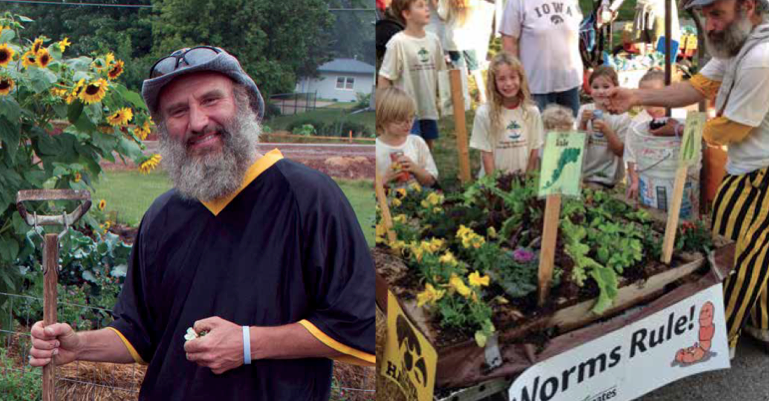Making Things Grow
When Scott Koepke was a young boy, his maternal grandmother Helen, a hearty, Northwoods Wisconsin farm girl who had a huge vegetable garden, introduced Scott to gardening basics. They would talk and harvest green beans, side by side, grandmother and grandson, gardening companions. She would stress that the most important aspect to gardening was soil health achieved through cover crops and compost. She taught by example, showing her grandson how to preserve food and store it in an old root cellar in the basement, a simple hole dug about fifteen inches into the in the ground where root crops could be stored perfectly throughout those brutal winters. Grandma Helen passed away when Scott was only in the 6th grade, but the memory of Helen and her garden come back to him, whenever Scott Koepke smells fresh tomatoes and basil.
Gardening, though an important part of his formative years, lay dormant until Scott joined the up as a Peace Corps Volunteer in Senegal after college at Iowa State. In the Peace Corps Scott trained in a program that that involved teaching vegetable gardening to supplement subsistence income in the rural village.
“That’s when my love for gardening really began to blossom. I was so blessed to be able to identify my passion.”, said Scott, a smile spreading across his face. “When I came back to the states, I wrote a curriculum called “Soilmates,” which started out as an introductory organic gardening class for children that I started taking to the public schools as a guest speaker.”
Soilmates has since grown into seven classes in the content areas of gardening, nutrition, compost, soil science, local food economy and life skills. Scott also consults on several school and community garden projects, and is now increasingly working with schools on diverting cafeteria food waste for compost. A seed library is in development, as well as an outreach to the homeless community with a garden called Welcome Home.
Teaching about soil health and gardening is not a job that gets a heading or even a subheading in the help wanted section. For Scott, it was a passion or what some might refer to as a calling, but up until a few years ago it was not a job. Scott would fit in teaching his Soilmates curriculum on the side, whenever he could. As a full time Grocery Manager at New Pioneer Cooperative in Iowa City, Iowa his drive to educate his community would have to occur before and after work. However, New Pioneer saw what Scott was doing and wanted to support his work. On a day that changed his path forever, Scott was pulled outside by his manager Matt Hartz to have a talk. Along the banks of Ralston Creek, Hartz asked Scott if he’d like to do Soilmates full time.
“I started sobbing tears of joy like a baby.” said Scott, “To have a grocery store put someone on salary to teach kids how to grow food and soil – are you kidding me?! I worked hard to get here, but am also the luckiest man on earth.”
Scott now serves the Iowa City Area in the newly created position as Education Outreach Coordinator for New Pioneer Food Co-op, incorporation his Soilmates organic garden education service for children into his work. Scott also serves as the President of the Board of Directors of the Iowa Valley Food Co-op and if you’re lucky enough to meet him, shake his hand; he might just turn your thumb green.
Here’s a taste of some of the things that Scott has to teach and some of his hopes for the future:
What are some of the obstacles in learning to garden? If you are a novice or coming back to gardening after a break, what advice do you have to offer?
Gardening, especially beyond flowers and into more food production, certainly isn’t for everyone. But I always like to walk folks through some of the common misperceptions of the work involved. My hyperbolic soundbite: Start small and get smaller. What I’m trying to say is that you should always start off to see what you can handle with what I call a “Kitchen Salsa Garden “ with a smattering of the usual suspects of veggies (both aboveground & root crops), plus a border of flowers & herbs to attract beneficial insects.
Another simple, affordable design to consider is the Native American 3 Sisters: a mound with sweet corn growing on the top, pole beans in the middle, climbing the corn like a natural trellis, and squash at the base. All three plants complement one another nutritionally. I’m also having a blast with kids lately planting living walls or pallet gardens. They can be especially useful for disabled access. Beyond annuals, the longer term goal for me is to, each cycle, incorporate more and more perennials into the mix if you have the room to allow the ripples in the pond to expand. This could mean starting out with just a nice bed of strawberries and asparagus. But, ultimately, I aspire to what my Soilmate brother, Fred Meyer of Backyard Abundance, teaches: Edible landscaping, food forests, permaculture! By the way, I can’t get enough of the descriptor “edible landscape”!
These are great places to start, but how much sweat equity are we talking about?
The first question I always have is, what are you goals? There are ways of designing a vegetable garden for home use that are less labor- intensive than one might think: a nice potato bed, for instance, is something you can plant in spring and pretty much walk away from all summer until harvest. I’m exaggerating, of course, to make a point, but don’t want people to think gardening is an unreasonable daily grind. It can be, but that largely depends on scale. In my experience in this zone (5), a 10’x10’ space, once established, can yield rotations of enough fresh produce to feed a small army from April through October, even longer with simple season extensions like cold frames, hoop houses, even dehydrators (plus Grandma’s root cellar!)
I was taught the French Intensive Method, a technique that can cram a lot into a relatively tiny area. Sure, spacing can be too crowded, which often exacerbates blight conditions, but I encourage people to do a little digging (pun intended) and research some mapping & companion options that can put the following in your yard & tummy: greens, tomatoes, peppers, beans, peas, cukes, carrots, onions, ‘taters, broccoli, squash, beets, basil, radishes. And those are just the direct-sow annuals!
You have done a lot of work to put vegetable garden in spaces like school yards, pedestrian malls, and community gardens. Why are these placements important to you?
A word about space. Not everyone has enough direct, full (preferably morning) sunlight essential at home in order to grow vegetables. You need a minimum of 8 hours per day. This is where communities need to increasingly come together in the commons to reclaim urban green space for food production.
When should we start thinking about getting our hands dirty?
The most labor-intensive time for me is usually late March/early April when, all depending on what Mother Nature provides, beds are prepared, seeds are sown, transplants are put in, thick mulch is applied and fencing (if needed) is installed. (Remember that beds need to remain moist daily until seed germinates.) Then you can kind of back off a bit and play defensive maintenance: supplemental watering in the absence of timely rains, minimal weeding (it’ll be minimal if you’ve applied that early, thick mat of mulch!), monitoring of pest conditions, both soil-borne or air-borne, that may require minimal, organic intervention, and, the best part: Harvest! Enjoying the fruits of your labors, oftentimes with several pickings off of the same, regenerative plant!
Speaking of weeding, some people say I’m crazy, but there are times when I actually enjoy weeding. It can be good exercise, I get into a zone, get some good thinking done and find it therapeutic. One man’s invasive is another man’s beneficial.
Many gardeners are tempted to reduce their workload by using pesticide or increase their yield by using chemical fertilizers? Where do you stand on these practices?
I’m unapologetically an organic educator. I’ll never say never, but I’ve been doing this for many, many years and have never once had to break out the big guns. Grandma taught me that the best pesticide is healthy soil. If I balance the soil, botanical immunities are enhanced. If I balance my diet, same thing. A central tenet of my teaching is the direct, causal link between biodiversity and balance. Honor the ancient wisdom. Observe and mimic nature. Enable conditions for nature to take care of nature. Learn from your mistakes. Know when intervention can do more harm than good. Over-application of synthetics has done severe damage to water quality. Less well-known is its destructive effects on microbes, the very microbes which, when decomposing organic matter in what we affectionately call the “poop loop,” are yielding chemically-available nutrients to root systems. I always ask my kids to ask themselves, “Am I helping or hurting?”
How can learning to plant a vegetable garden transform our world?
Ah ha! Now we’re cookin. This is why I get up every morning and do what I do. This goes way beyond carrots. Soilmates is about life skills, perhaps the most important of which is learning the act of nurturance. The others in my class for at-risk kids are: balance, respect, patience, humility, healthy choices, trust, listening … everything I need to know I learned in the nature’s classroom, the garden.
Research affirms what I have witnessed firsthand with people dealing with trauma in many forms: Gardening Heals People. I don’t know how else to say it. And when I get depressed about the greed and hubris and legal pollution on this planet, I return to the garden with children. Therein lies my hope.





